May 16. AIT BENHADOU - MARRAKESH Aura and Zydre were spot on the next morning when they predicted a taxi driver would be conveniently milling around the hotel. The waiter still smelled "kickback". We weren't in any great hurry and took our time over breakfast. The waiter wanted 500 for the taxi ride to Marrakesh, down from his impossibly low price of 600 from the night before, and we offered 400. He talked to the driver and agreed to the 400 but then reneged and said he told us 500. It was possible that he misspoke but we had reconfirmed it with him and it was more likely he was trying to pull a fast one. We just really didn't like the guy. Rob went out to talk with the taxi driver himself and we settled on 450.
The ride to Marrakesh was up and over the Atlas mountains but with the snow cover so light the scenery wasn't very dramatic. Zydre was impressed with the winding road but I was getting car sick from it. We finally made a rest stop at a cafe. We 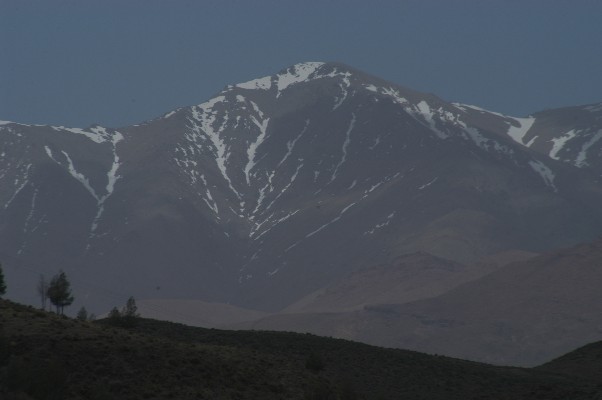 had tried to get the driver to stop in an earlier town where a market was going on but he didn't seem to think we would enjoy that atmosphere and insisted that we go further to a touristy place. The cafe was empty except for the man and woman who ran the place and their small boy. The boy kept hitting or kicking two small puppies that were running around the yard. This left a bad taste in my mouth. Dogs are rather poorly treated in Morocco and considered unclean while cats are the Prophet Mohammed's chosen pet. This boy's father seemed quite pleased with his sons behavior and it just made me ill. So, the whole rest stop experience wasn't very restful. I was just eager to get to Marrakesh. It wasn't much farther and fortunately the road straightened out. had tried to get the driver to stop in an earlier town where a market was going on but he didn't seem to think we would enjoy that atmosphere and insisted that we go further to a touristy place. The cafe was empty except for the man and woman who ran the place and their small boy. The boy kept hitting or kicking two small puppies that were running around the yard. This left a bad taste in my mouth. Dogs are rather poorly treated in Morocco and considered unclean while cats are the Prophet Mohammed's chosen pet. This boy's father seemed quite pleased with his sons behavior and it just made me ill. So, the whole rest stop experience wasn't very restful. I was just eager to get to Marrakesh. It wasn't much farther and fortunately the road straightened out.
Marrakesh wasn't love at first sight but its history promised more. It was founded in 1062 by Almoravid sultan Youssef bin Tachfin. Using money from plundering Spain, he built Marrakesh into a beautiful city and cultural center of Morocco. The city's heyday was under his son, Ali, the son of a Christian slave wife. Ali built the underground irrigation system that still feeds he city's gardens and artisans from Muslim Spain started building Andalucian-style buildings. But, much of this was razed in 1147 by the Almohads, only to be rebuilt again by more Andalucian artisans. Marrakesh was capital until collapse of Almohad Dynasty in 1269 and it became capital again in 16th century under Saadian dyn. The city held an important place in the history of the country and while it doesn't have the same degree of medieval atmosphere that has been preserved in Fes it was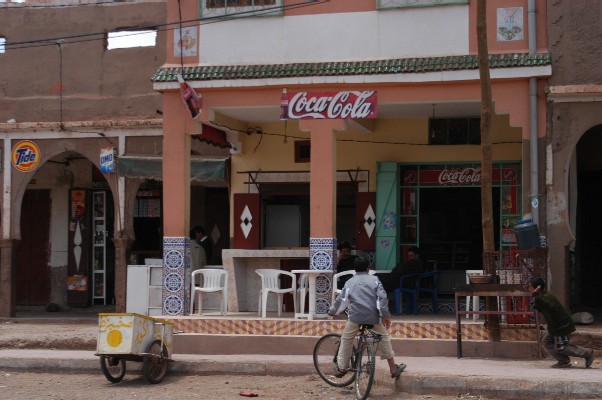 still an interesting place. still an interesting place.
We dropped the Lithuanians at the bus station and saw them engulfed in touts as we pulled away. The taxi dropped us near Djeema el-Fna, the heart Marrakesh's medina, large square that comes to life every afternoon with row after row of food stalls and a variety of street performers. It was rescued from becoming a parking lot which was fortunate because it remains Marrakesh's top attraction.
Getting a hotel nearby was easy enough and we had lunch at a tasty schwarma restaurant. The newly paved streets leading away from the square almost had the feel of as outdoor mall back home but the other side of the medina was full of narrow streets full of shops and a never ending souk. As we ate lunch a young boy came begging at the table. He was dressed very shabbily and looked so desperate. It was sad but giving money to children is almost always a bad idea. It only encourages the parents to send their kids out to beg. He had moved onto the next table when a police men on a scooter swooped in a grabbed him by the collar. Marrakesh has been known for its density of touts and beggars but a serious effort is underway to keep things under control. Too many tourists left vowing to 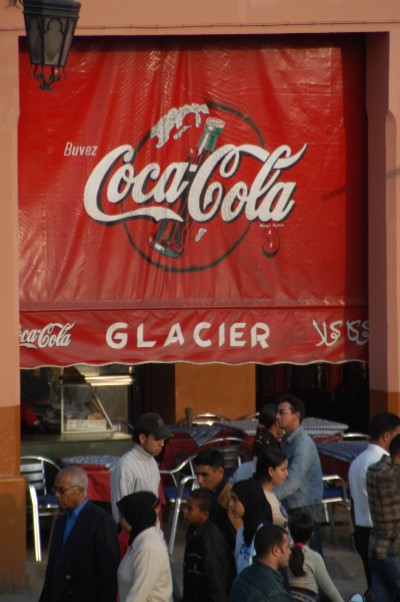 never come back. There is also the added security risks posed by last year's bombing in Casablanca and the country can't afford any more bad exposure. The boy cried for his life when he got taken away. (But, we saw him back on the streets two days later.) never come back. There is also the added security risks posed by last year's bombing in Casablanca and the country can't afford any more bad exposure. The boy cried for his life when he got taken away. (But, we saw him back on the streets two days later.)
Unlike the brown earth that gave the walls and houses of Fes their color, Marrakesh is dominated by the ochre color of the Sahara. Overall Morocco's town have maintained incredible consistency in the development of its historical town. All of the way down the Sahara the villages stayed true to the pink hues, whether using traditional mud building methods or the modern concrete.
The souks of Marrakesh were much more extensive than Fes, being a much larger medina, but they were all shamelessly targeted at tourists. One whole alleyway was dedicated to wildly colored babouches (Moroccan slippers), in styles only purchased by foreigners. Off the main square were souks housed in covered small shopping centers. As we entered one a man grabbed my arm to get me to look in his shop. I shook my head and said "Don't touch me!". He gave me a sassy look back and said "Why not?". I pointed at Rob who was a couple of yards behind me and he yelled at the guy. The result was always the same. They made aggressive and obnoxious gestures and when you responded with predictable anger they changed to the "What is the big deal?" attitude, trying to make the whole scene out to be your doing. It was maddening and perplexing. Were they ever actually successful with these tactics? Who falls for it? Even if I might have looked at a shop I changed my mind at the slightest hint of tout behavior. They lost the business before the had a chance to get it. Not long after th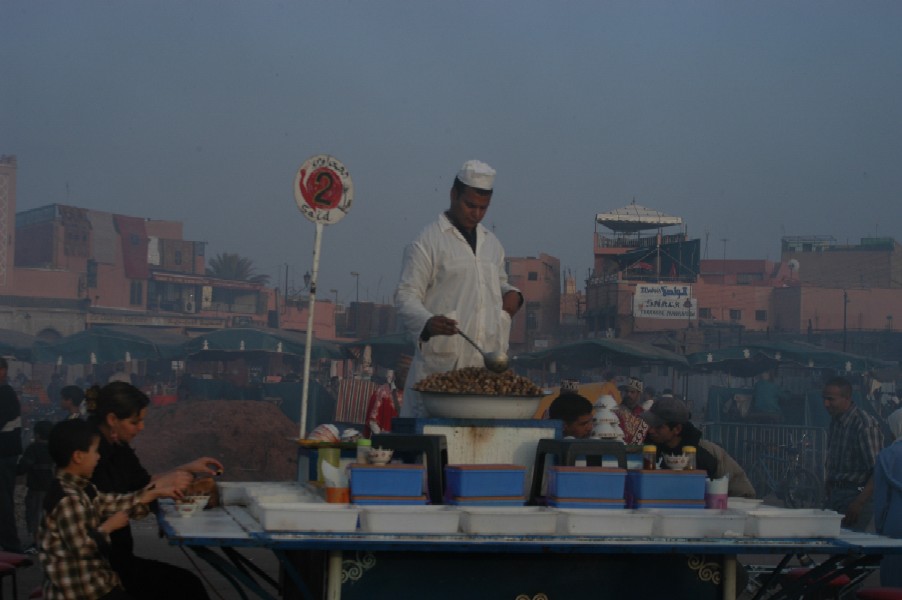 e arm grabber we were stalked by another tout who kept whispering comments to Rob. "Where are you going?" "What are you looking for?" "Do you want jewelry?" Rob turned around and told the guy to leave us alone but he kept it up. When Rob turned around again he shrugged his shoulders and said he was just going the same way as us and what was the problem? Rob blocked the narrow walkway and kept telling the guy to go away, using them relentless tactic until the guy decided he would change the way he was going. It didn't take long before enough was enough. It took all of the fun out of even trying to shop. e arm grabber we were stalked by another tout who kept whispering comments to Rob. "Where are you going?" "What are you looking for?" "Do you want jewelry?" Rob turned around and told the guy to leave us alone but he kept it up. When Rob turned around again he shrugged his shoulders and said he was just going the same way as us and what was the problem? Rob blocked the narrow walkway and kept telling the guy to go away, using them relentless tactic until the guy decided he would change the way he was going. It didn't take long before enough was enough. It took all of the fun out of even trying to shop.
With the density of tourists in Marrakesh and such a tourist dependent economy the competition was fierce. At times the square was so full of camera toting tour groups that I felt like I was in a new section of Disneyland. Most of the tourists were dressed vulgar by local standards as well. I am sure the loss of respect that their clothing and attitudes engendered didn't help the local-tourist relationship either.
As the Djeema el-Fna came to life in the evening, smoke was seen rising from the densely packed food stalls, creating a haze in the sky as the sun set. The street entertainers increased in numbers and ranged for the more traditional story tellers to a group of men dressed as belly dancers. There was an interesting guy who sang with chickens, another who played songs on his traditional string instrument, and, of course there were "snake charmers". They weren't as exotic as it sounds. The cobra snakes have their mouths sewn shut which made them safer in a crowd but it was a rather pathetic sight. I you weren't looking they would come up from behind and wrap the snake around your neck. I 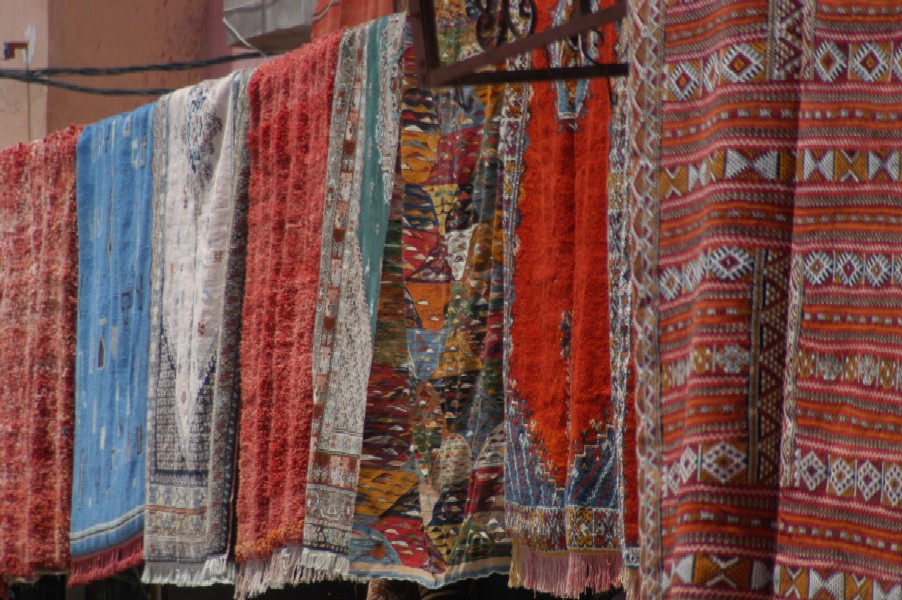 keep a good watch out. The depressed monkeys on leashes were really sad as well, hunted from their natural habitat for the purpose. The story tellers were the most popular with the local people and I really wished that I could have understood them. keep a good watch out. The depressed monkeys on leashes were really sad as well, hunted from their natural habitat for the purpose. The story tellers were the most popular with the local people and I really wished that I could have understood them.
One side of the square was lined with juice carts. One guy made "tsk tsk" noises to attract tourist. Rob went "tsk tsk" back and after a few passes he had the guy laughing. We stopped for tea in a cafe that over looked the far end of the square. It was actually better viewed from a distance than from up close. A group of women were selling hats and henna hand painting below us. Every once in a while the police would come by and we would see them all scatter.
Easily victims of habit we went back to the schwarma place for dinner and the very same waiter helped us. When he found out that we knew Japanese he came over with is little list of words. He eagerly asked us to help him with some key phrases. "Here we go again", I thought. We agreed to help out the following night. |

